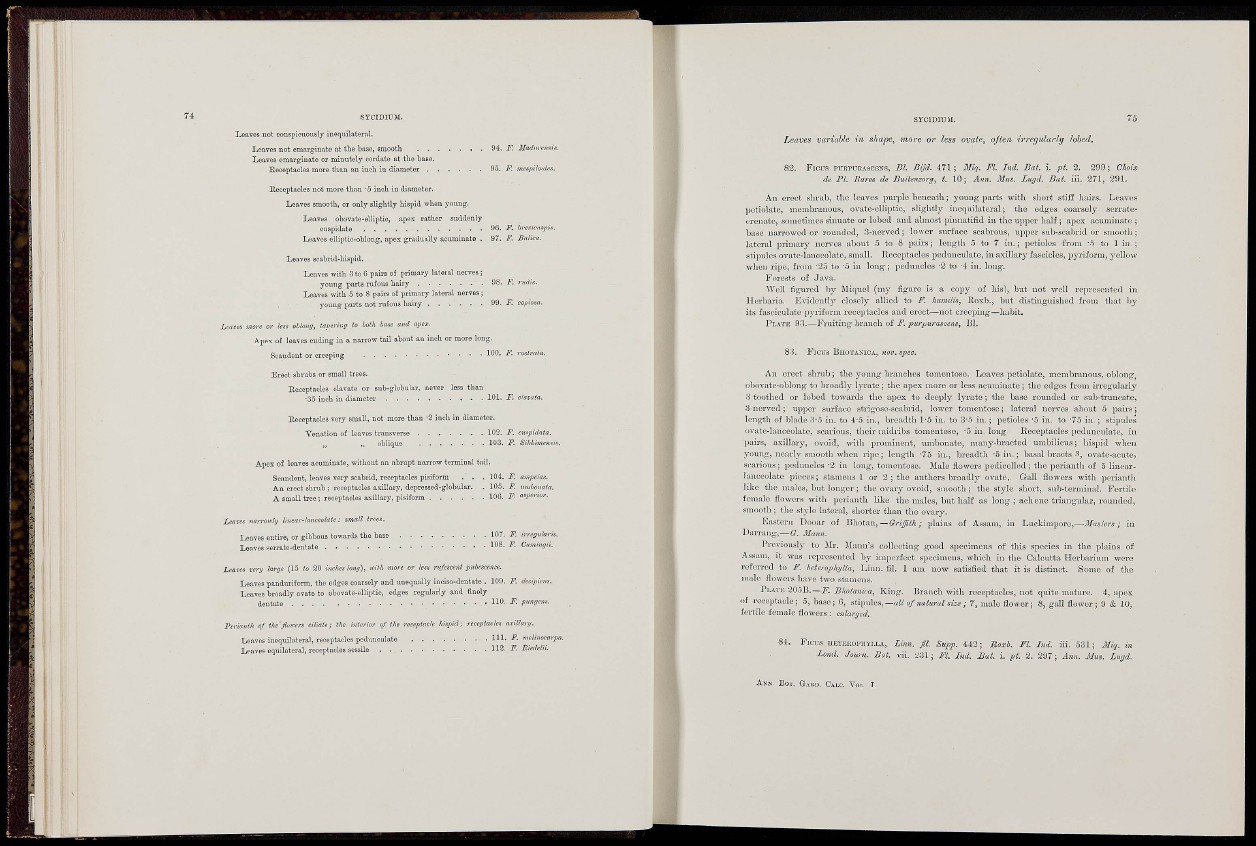
SYCIDIÜM.
not conspicuously inequilateral.
Leaves not emarg-inate at the fcaso, smooth 94. i^. Madureiisis.
Loaves emarginate or minutely cordate at the base.
Receptaoles more than an inch iu diameter 95. F. mespiloides.
Eeceptaeles not more than -5 inch in diameter.
Leaves smooth, or only slightly hispid when young.
Leaves ohovate-elliptio, apes rather suddenly
cuspidate 9G. F. hvevicuspk.
Leaves elliptic-oblong, apes gradually acuminate . 97. F. Balica.
Leaves scabrid-hispid.
Leaves with 3 to 6 pairs of primary lateral nerves;
young parts rufous hai ry 98- F. ruáis.
Leaves with 5 to S pairs oí primary lateral nerves;
young pai-ts not rufous hairy 99. -F. copiosa.
Leavvs more or less oblong, taperiari to both base ami apex.
Apes of leaves ending iu a nai-row tail about an inch or more long.
Scandent or creeping 100. F. ro,lr«ta.
Erect shrubs or small trees.
Eeceptaeles clávate or sub-globular, never less than
•35 inch iu diameter 101. F. davata.
Eeceptaeles very small, not more than -2 inch in diameter.
Yenation of leaves transverse 102. F. cmpidata.
jj „ obliquo 103. F. Sihkimmsis.
Apes of leaves acuminate, without an abrupt narrow terminal tail.
Scandent, leaves very scabrid, receptacles pisiform . . . 104, F. ampeias.
A n erect shrub ; receptacles asillary, depressed-globular. . 105. F. umbonaia.
A s m a l l t i - e e ; receptacles asillary, pisiform 106. F ««i'mor.
Leaves narrowly linear-lanceolate: small trees.
Leaves entire, or gibbous towards the base 107. F. imgularis.
Leaves ser rate-dentate 108. F. Cmmngii.
Leaves urrj large (15 to 20 inches long), with more or less rufescent pubeseense.
Loaves panduriform, the edges coarsely and unequally inciso-deutate . 109. F. declpiens.
Leaves broadly ovate to obovate-elliptic, edges regularly and finely
dentate • HO' pm^ens.
Perianth of the fioicers ciliate; the interior of the receptacle hispid; receptacles axillary.
Leaves ineqmlateral, receptacles pedunculate 111. F. mclinocai-pa.
Leaves eqixilateral, receptacles sessile . . . . 112. F. Eiedelii.
SYCIDIDM. 75
Leaves variable in shape, more or lass ovate, often irregularly lohed.
82. Ficirs PURPURASCKNS, Bl Biß. 471; Miq. Fl. Ind. Bat. i. pt. 3. 299; Choix
de Pi. nare$ de Buitenborg, t. 10; Ä/ui. IIus. Lugd. Bat. Hi. 271, 291.
An erect shrub, the leaves pui-ple beneath; young parts with short stiff hairs. Leaves
petiolate, membranous, ovate-elliptic, slightly inequilateral; the edges coarsely serratecronate,
sometimes sinuate or lobcd and almost pinnatifid in the upper half ; apex acuminate ;
base naiTO-vved or roundedj 3-nerved; lower surface scabrous, uj^per sub-scabrid or smooth;
lateral primary nerves about 5 to 8 paii-s; length 5 to 7 in.; petioles from --T to 1 in ;
.sti])ules ovate-lanceolate, small. Recc2>tacles pedunculate, in axillary fascicles, pyriform, yellow
when ripe, from '25 to -5 in long; peduncles -2 to 4 in. long.
Forests o£ Java.
Well figured by Miquel (my figure is a copy of his), but not well I'cpresented in
Herbaria. Evidently closely allied to F. humilis, Roxb., but distinguished from that by
its fasciculate pyriform rcccptacles and erect—not creeping—habit.
PLATB 93.—Fruiting branch of F. purpurascens, Bl.
83. Ficus BHOTANICA, nov. spec.
An erect shrub; the young branches tomentose. Leaves petiolate, membranous, oblong
obovate-oblong tn broadly lyrate; the apex more or less acuminate; the edges from in-egularly
3 toothed or lobed towards the apex to deeply lyrate; the base rounded or sab-truncate,
3-nerved; upper surface strigose-scabrid, lower tomentose; lateral nerves about 5 pairs;
length of blade 3-5 in. to 4'5 in., breadth 1-5 iu. to 3-5 in.; petioles -5 in. to -75 in.; stipules
ovate-lanceolate, scarious, their midribs tomentose, '5 in. long Receptacles pedunculate, in
pairs, axillary, ovoid, with prominent, umbonate, many-bracted umbilicus; hispid when
young, neai'ly smooth when ripe; length -75 in., breadth -Sin.; basal bracts ovate-acute,
scarious; peduucles -8 in long, tomentose. Male flowers pedicelled; the perianth of 5 linearlanceolate
pieces; stamens 1 or 2 ; the anthers broadly ovate. Gall flowers with perianth
like the males, but longer; the ovary ovoid, smooth; the style short, sub-terminal. Fertile
female flowers with perianth lilce the males, but half as long ; achene triangular, rounded,
smootli; the style lateral, shorter than the ovary.
Eastern Dooar of Waota-ii,—Griffith; plains of Assam, in L u c l dmp o r e ,—; in
Darrang,—C. Mann.
Previously to Mr. Mann's collecting good specimens of this species in the plains of
Assam, it was represented by impijrfect specimens, which in the Calcutta Herbarium were
referred to F. heterophijlla, Linn. fil. 1 am now satisfied that it is distinct. Some of the
male flowers have two stamens.
PLATE 20.'513.—J". Bkotanica, King. Branch with receptacles, not quite matiu-e. 4, apex
of receptacle; 5, base; 6, stipules,—«« of natural size; 7, male flower; 8, gall flower; 9 & 10,
fertile femal e flowers ; enlarged.
84. F:CU8 HETEEOPHYIXA, Linn. fil. Supp. 442; Boxk Fl. Ind. iii. 531; Miq. in
Lond. Journ. Bot. "vii. ¿31; FL Ind. Bat. i. pt. 2. 297; Ann. Mus. lugd.
ANN. BOR. GAUD. CALC. YOL. I.